|
Torreya taxifolia near Columbus, OHIO
DAWES ARBORETUM
• DAWES ARBORETUM list of ACCESSIONS of Florida Torreya, with MAP of locations onsite.
 |
|
The Dawes Arboretum in central Ohio received 10 seeds from the Fall 2006 seed production of Biltmore Gardens Florida Torreya trees via Lee Barnes of Torreya Guardians. Four seeds germinated.
Two seedlings were planted beneath a semi-wild deciduous canopy April 2013. The photos below show the healthy growth of these two torreyas: first site visit May 2015 and second, June 2016.
|
The remaining two seedlings from 2006 Biltmore seeds were outplanted beneath a white pine canopy Spring 2014. This site at the top of an exposed north-facing slope, however, proved fatal to the two outplants — surely owing to cold, dessicating winds during the winter of 2014/15 and possibly also to Torreya's inability to link up with the kind of mycorrhizal network that pines attract.
 |
|
20 more seeds from the Biltmore 2009 fall harvest were sent to Dawes via Lee Barnes spring of 2010. Torreya Guardians donated 300 seeds Fall 2014; as of May 2015 about 100 of those had germinated. Dawes also received (via A.J. Bullard) about 50 seeds from the pair of the pair of Mt. Olive NC Torreya trees, which are descendants of two mature Torreyas on the Kennedy property at Clinton NC (one of the two was killed by a falling pine in a subsequent storm).
|
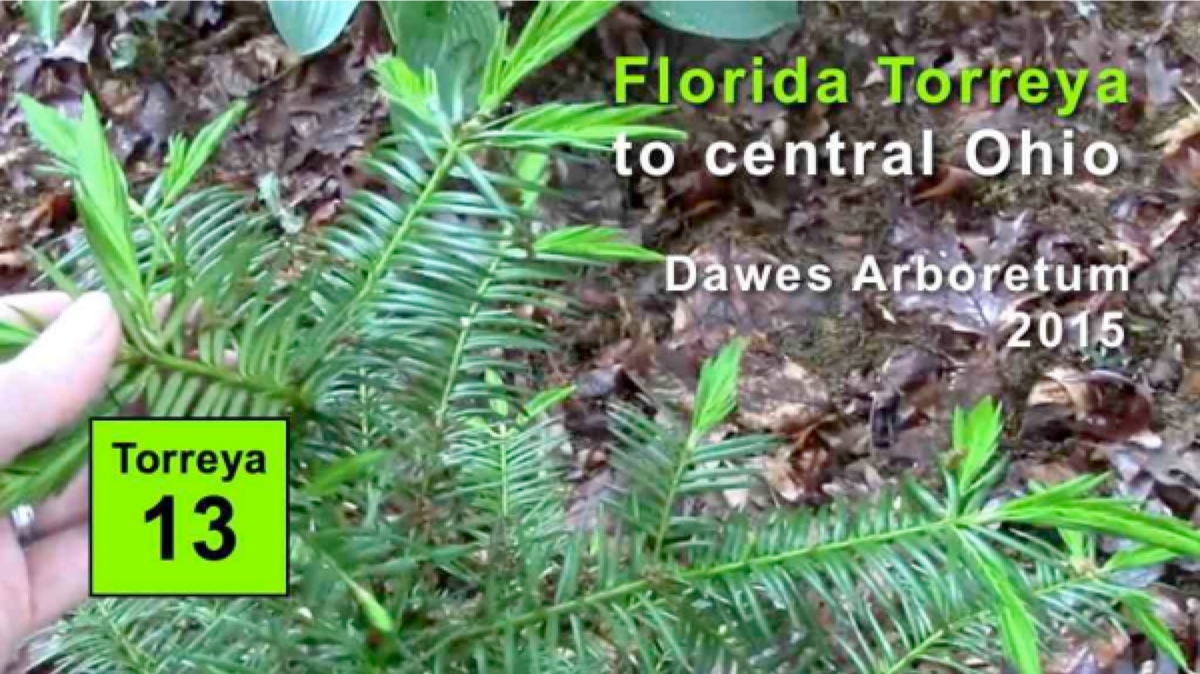 |
|
VIDEO 13: Florida Torreya to Ohio's Dawes Arboretum (May 2015)
Dawes Arboretum (Newark, Ohio) received ten seeds from Torreya Guardians from the 2006 harvest by Biltmore Gardens (Asheville, NC). Possible learnings are: (1) A full deciduous canopy of oak and maple seems to be superb habitat for Torreya in central Ohio. (2) Exposure to full sun and especially to polar winds seem to be very stressful to this genus. Video also compares Florida Torreya's leaf and branch morphology against two sister species native to Asia that have been planted in Dawes Arboretum: Torreya grandis (China) and Torreya nucifera (Japan). 23 minutes - filmed May 17, 2015. |
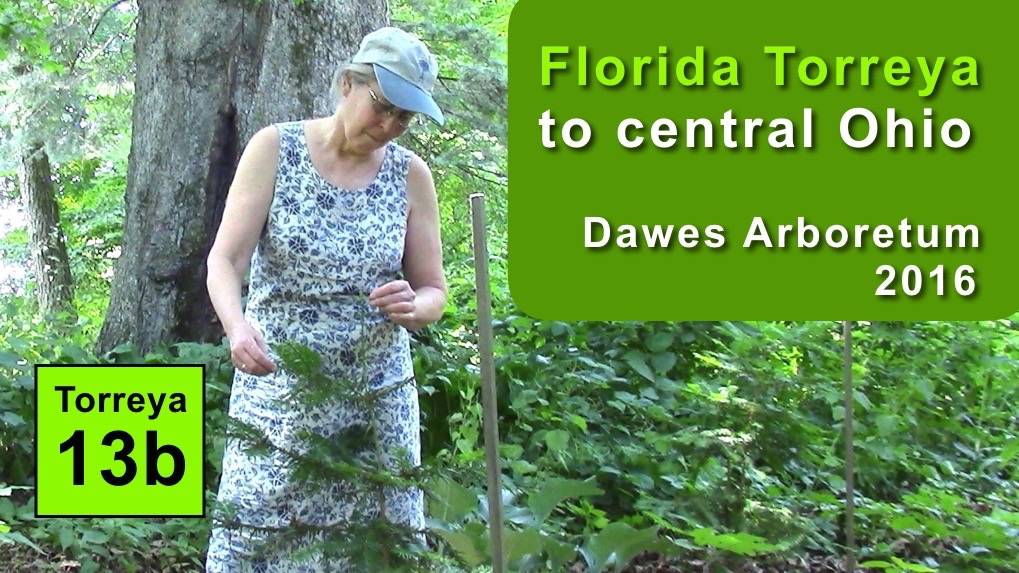 |
|
13b: Florida Torreya to Ohio's Dawes Arboretum (June 2016)
Documents superb annual growth on the two Florida Torreya specimens beneath a full deciduous canopy (and protected from winter winds by a border of evergreen conifers). Confirms 1-month difference in vegetational budburst bt the Florida Torreya (May budburst) and adjacent Chinese Torreya (June budburst). Speculation on the importance of nearby maple helping the Torreyas by shared fungal root symbionts. 17 minutes - filmed June 18, 2016 |
Photos from the 17 May 2015 site visit




 |
|
Two seedlings germinated from the 2006 seeds donated by Biltmore Gardens were outplanted beneath a white pine canopy Spring 2014.
PHOTO LEFT: This site at the top of an exposed north-facing slope (see shadows of white pines foreground in the early afternoon May 2015 sun) proved fatal to the two outplants — surely owing to cold, dessicating winds during the winter of 2014/15 and possibly also to Torreya's inability to link up with the kind of mycorrhizal network that pines attract and overall lacking the diverse fungal network of forest (rather than landscaped) soil.
Note: The photo was taken from behind a staked, caged Torreya plant that was dying. See the cage top at bottom of the photo.
|
Failure to thrive in this case offers a crucial lesson in helping us all hone our guidance for where not to plant in the future (at least in states northward of Georgia.
Photos from the 18 June 2016 site visit


PHOTOS ABOVE: Michael Dowd shows the top of one of the two staked Florida Torreyas (the other one is foreground right). A large White Oak graces the background, while the brown trunk of a Japanese maple is foreground.
PHOTOS BELOW: Looking straight up from one of the torreyas one sees the subcanopy maple arching overhead. The tall white oak canopy is higher still. Notice that maples share the same arbuscular type of symbiotic mycorrhizal fungi as does genus Torreya. The superb health of the two torreya specimens (which extend skyward their apical growth every year) suggests a superb habitat: excellent soil, deciduous canopy, winter wind blockage, mycorrhizal assistance, and likely access to excess canopy production of sugars via the Wood Wide Web.


UPDATE by Connie Barlow: As a follow-up to the above 2016 video, I posed the following question by email to our contacts at Dawes Arboretum. Their answer follows.
QUESTION (by Connie Barlow): "I am trying to understand why your Torreyas are so vibrant. Obviously, the protection from harsh winter winds (compared to the ailing Torreyas you removed from Dawes elsewhere) is important in that little grove. But I also wonder if fungal root symbionts have "decided" that they will route sugars gained from the Japanese maple to support the little Torreyas in having vigorous summer growth — and then the torreyas become a source of sugar for the root fungi network when the Acer ceases photosynthesis in the fall? The reason I speculate is that we have been told that Torreya seedlings are sometimes difficult to transplant successfully if one wants to relocate them; so maybe the reason is that, although they still have fungal root symbionts after the transplant, those symbionts have lost their network connection to surrounding plants that could send sugars."
ANSWER (by Gregory Payton 18 July 2016 email): "Honestly, we have done nothing differently to the Torreya that are doing so well than we do to any other plant planted here! No soil amendments or special techniques. I think you are correct in saying the environment they are in is hospitable to their survival. The area noted seems to be fairly free of disturbance in the past and was probably never farmed making the soil horizon and associated micro-flora more natural".
QUESTION (by Connie Barlow): "I recall that you still had quite a few seedlings of Torreya to outplant or otherwise disperse. I also noticed while visiting this spring that very near the Torreyas, the garden has been dug up and looks ready for big new plantings. Would it be possible for you to ensure that at least a half dozen torreyas go in there? Your torreyas come from Biltmore seed stock, which is rare, so it would be great to keep that going. Because genus Torreya individuals are either male or female, at least a half dozen trees must be near one another to ensure production of seeds."
ANSWER (by Gregory Payton 16 August 2016 email): "Yes, we will try to plant a sufficient number of our Torreya from the nursery into this area. The "dug up" area nearby was a garden and bridge for a new trail that was constructed. I do not think the design of that area allows for Torreya but we can plant some in the vicinity."
UPDATE 21 SEPTEMBER 2018: Editor's note: Gregory Payton is Director of Living Collections at Dawes. He responded to a September 20 lengthy email from Connie Barlow. Barlow requested an update on progress of the Torreya seeds received from us over the years. As well, she included background on the hostility that had developed with Atlanta Botanical Garden in recent years, news of Barlow's FOIA data request (seeds produced in official ex situ plantings over the years) and the follow-up successful outreach to higher-level staff of U.S. Fish & Wildlife service. As well she sent a summary explanation and a draft of her recommendations re Endangered Species Act regulations update (which she sent to all the lead Torreya planters plus this one arboretum). Payton responded:
"It has been a very busy week preparing for a large Fall Festival here this weekend. I have not had a chance to read the material but are still committed to helping preserve this species in our collections. We are not planting this species in the wild for any kind of "assisted migration" but intend to preserve the plant ex situ. We do have many more plants growing from the 2014 seeds from Jack Johnson. We intend to plant more in similar areas as the existing plants are growing now. Doing VERY well, BTW! We do have extras in a seedbed that need lifted soon. We have sold some to local plant aficionados as well! Best of luck!" Greg
UPDATE AUGUST 2020 by Connie Barlow: On August 21 I sent a detailed email to Gregory Payton and Richard Larson at Dawes, alerting them to Torreya Guardians being featured in a new book, The Journeys of Trees, and also summarizing three key learnings by our group that might be of use to Dawes's own propagation efforts for this species:
1. SEED PRODUCTION IN CLEVELAND: Fred Bess began achieving seed production of his Florida torreya trees in a suburb of Cleveland (Parma) in fall 2017. I visited onsite Fall 2018 and filmed his small grove, including some of the 23 seeds still hanging on the south-facing side of his tallest female. You can access this video and Fred's site information here: http://www.torreyaguardians.org/ohio-cleveland.html
2. DOCUMENTATION OF HISTORIC GROVES OF FLORIDA TORREYA: Our lead planter in Michigan, Paul Camire, and I collaborated on producing an easy-to-use "Historic Groves" webpage (and fully detailed pdf) of all the historic grove plantings. Crucially, we highlight the 4 locations where the plantings have fully "naturalized" — proving those sites are not only capable of producing seeds but seeds distributed nearby by squirrels will (with no human assistance) grow into seedlings and saplings. Here is the webpage: http://www.torreyaguardians.org/historic-groves.html I will let you know when, later this year, the Journal of Ecology publishes a special section on the role of existing horticultural plantings in offering support for plant translocations helpful for climate adaptative projects in the future. U.K. botanical ecologist, Sarah Dalrymple, is coordinating the publication of papers on this topic. She, along with Canadian forester Richard Winder, formed an international Plant Translocation Network two years ago. Jesse Bellemare (botanist at Smith College) will have a paper in that volume, owing to his crucial work in documenting naturalization of Umbrella Magnolia into the surrounds from the historic plantings in the garden where Emily Dickinson lived, followed by his 2017 paper in Rhodora on "Climate change, managed relocation, and the risk of intra-continental plant invasions: A theoretical and empirical exploration relative to the flora of New England."
3. USE BASAL CUTTINGS TO ACHIEVE TORREYA CLONES THAT BECOME TREES (NOT SHRUBS). One of our TN volunteers, Clint Bancroft, has successfully nurtured tree-form torreyas, rather than the usual shrub form, by using cuttings taken from basal sprouts rather than branchlets. The century-old Harbison House Torreya grove near Highlands NC has prolific basals (not many seeds, though, as overshaded by dense decidous canopy). The owner let Clint collect basal tips, and these are what he used for his experiments. You can see his success at a June 2020 entry on his (long) torreya webpage: http://www.torreyaguardians.org/tn-ocoee.html Crucially, even when rodents nip off the growing apical tips, the stem resprouts a new apical leader. This offers up tremendous possibilities for botanical gardens to collaborate in ex situ safeguarding of exact clones that will indeed ultimately produce fully formed trees — whole groves of torreyas, such as we encounter at the Biltmore and Harbison House.
AUGUST 22 RICHARD LARSON OF DAWES RESPONDED:
Connie - Thanks for the update including the surprising reproductivity of the species in northern Ohio. At The Dawes Arboretum we are encouraged by the performance of Torreya taxifolia although our plants are not yet reproductive. I would now expect that our plants will achieve maturity and cone production. It appears also that the species is quite resistant to deer browse and we are not obligated to fence them as with the closely related Taxus sp.
August 25 addendum by Richard Larson: "I expected deer to browse them [the torreya seedlings] and we do fence young plants in every case even though when they mature, they are resistant or rarely immune. But a recent planting has not been fenced for 2 years now and so far, no deer browse has been observed. That is only one example of course and hardly translates into declaring them as resistant as Asimina, Buxus, Berberis, Spiraea, Cryptomeria or Cephalotaxus, but it seems promising."
JULY 2022 PHOTOS ON THE INTERNET of the two Florida torreyas at Dawes
(thanks to Lucas Machias)
OCTOBER 2024 PHOTO ON THE INTERNET of the two Florida torreyas at Dawes
(thanks to Lucas Machias)
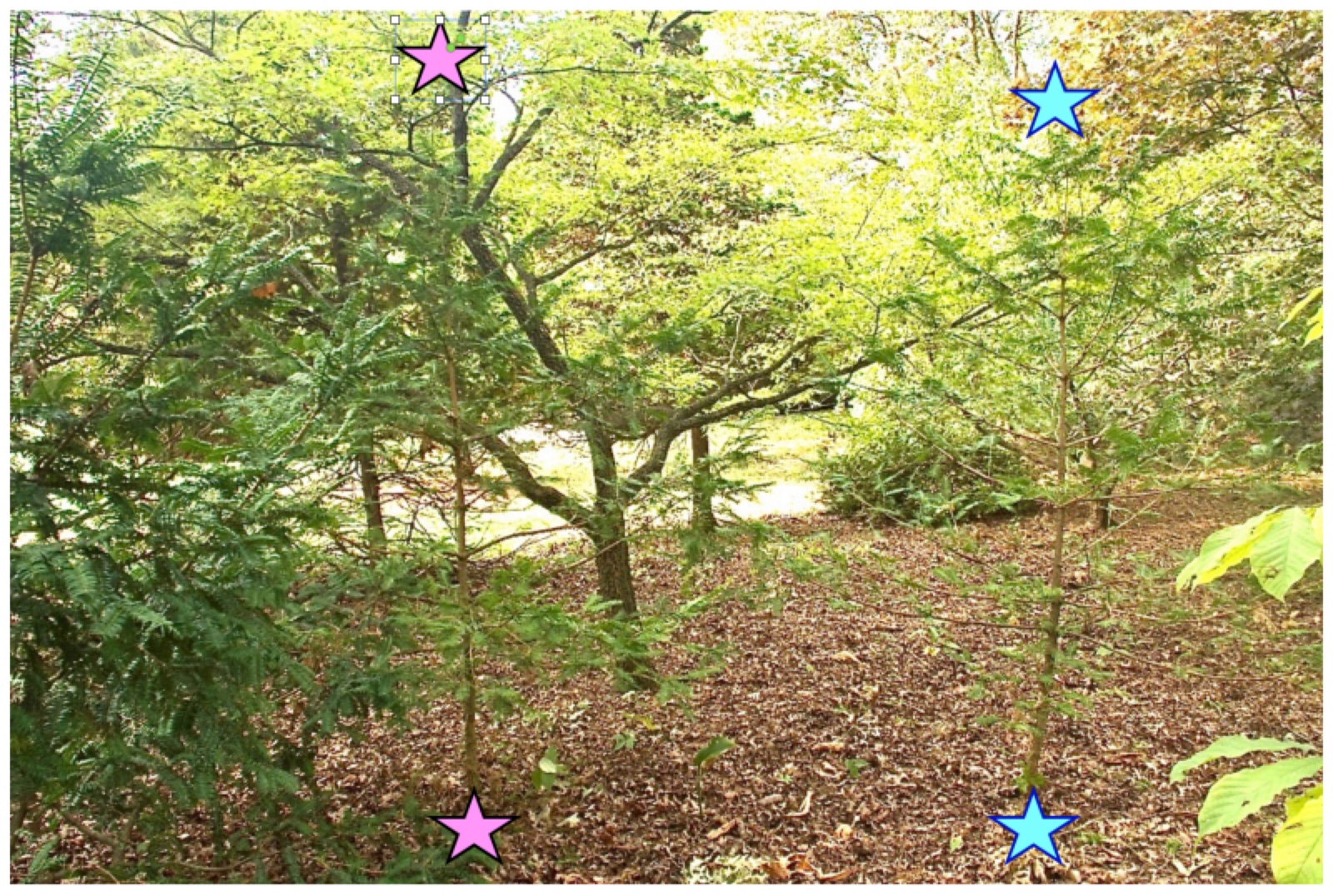
Tops and bases of the TWO FLORIDA TORREYAS are marked by stars. On the left is a brushy Asian species of torreya. It will never become a tree form because it began as a rooted branchlet. The two Florida torreyas were started from seeds donated by the Biltmore Gardens and transited through Torreya Guardians.
NOVEMBER 2024 - current images and accession numbers on the Torreya taxifolia page
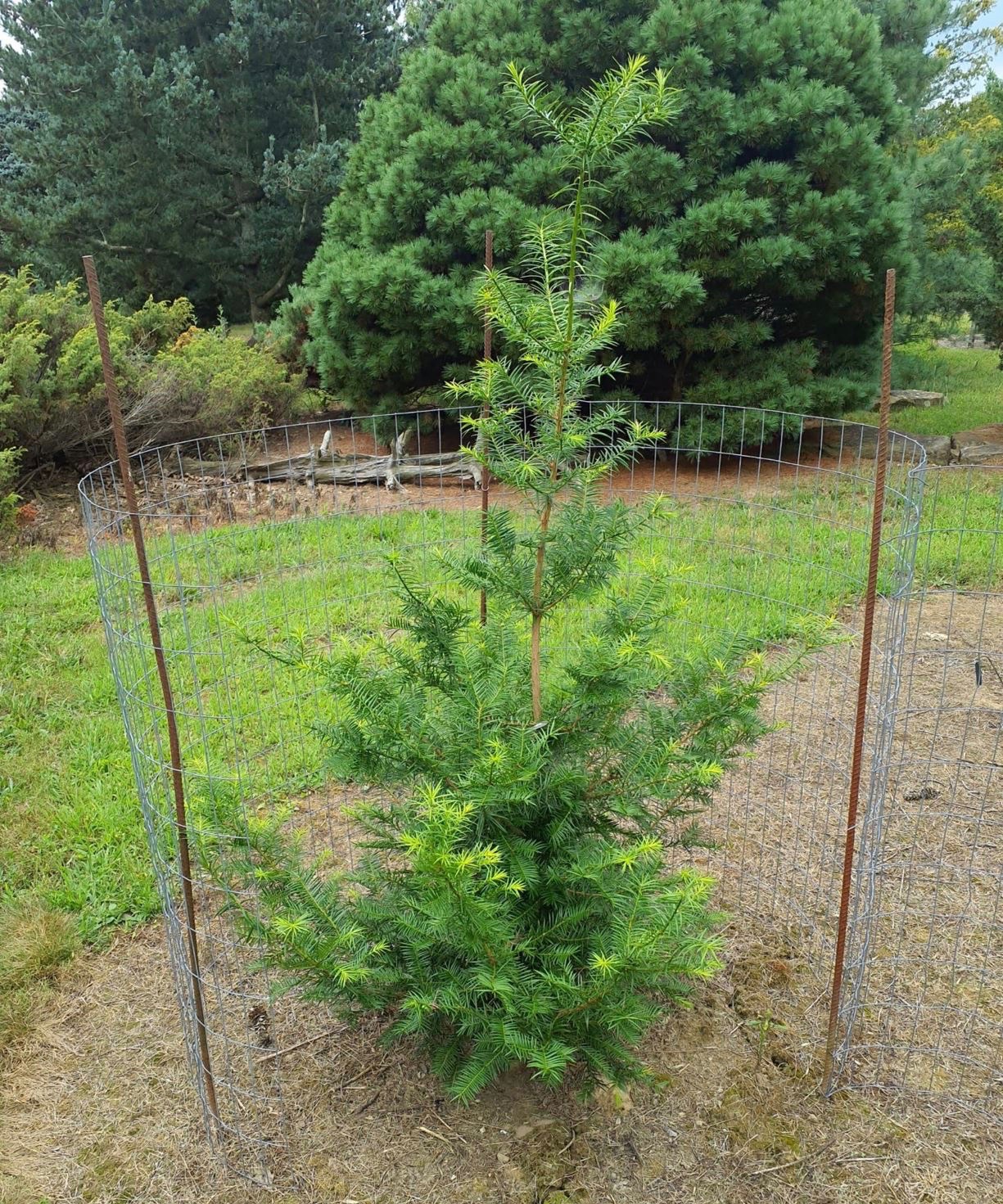 |
|
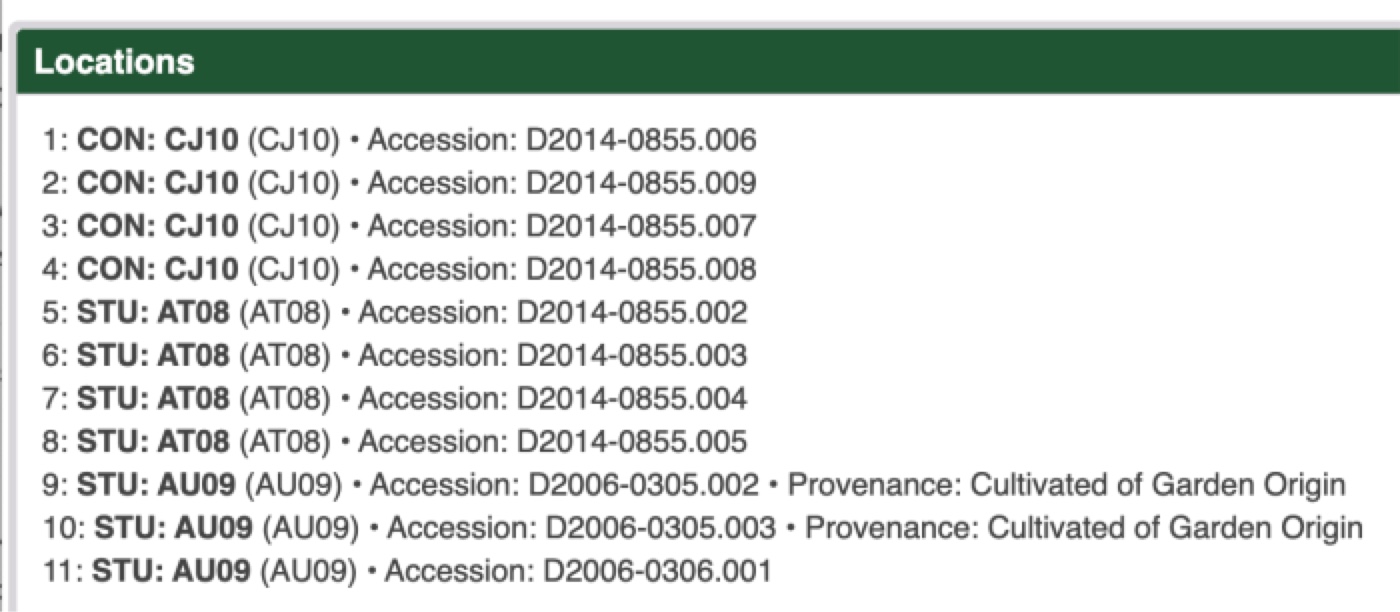
LEFT: Photo by Greg Payton on p.2 of the Torreya taxifolia page.
ABOVE: A total of 11 current outplantings (same link).
|
Return to HOME PAGE
|